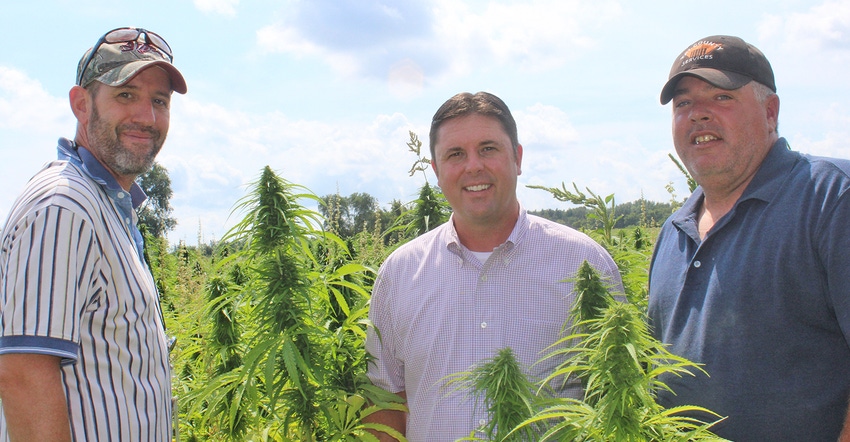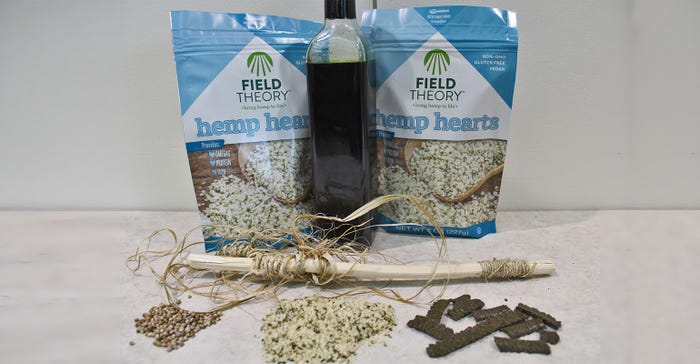
In 1943, the U.S. government was encouraging farmers in Renville County to grow hemp because World War II cut off imports from Asian sources. A plant was built in Bird Island for extracting fiber. However, in 1944, the crop was never processed, and after the war ended in 1945, imported fiber was again available.
According to "Looking Back: A History of Agriculture in Renville County, Minnesota," by Frank D. Svoboda, the plant was sold to a group of men who converted it to an alfalfa dehydrating facility.
Seven decades later, Minnesota farmers are again planting hemp. About 40 people gathered at the Minnesota Department of Agriculture in late January to discuss the crop, its uses and planting requirements.
Minnesota is one of several states to have a pilot program allowing for the cultivation of industrial hemp, which was allowed under the 2014 federal Farm Bill. State legislation allowed Minnesota to begin the program in 2016, when six producers planted 38 acres, said assistant MDA commissioner Andrea Vaubel. Thirty acres were harvested. Eight acres couldn't be harvested because of too much rainfall.
John Strohfus of Hastings planted 18 acres of industrial hemp in 2016, making him the state's largest grower.
He planted June 17, nearly a month after his planting date goal because of delays in getting seed. The hemp was harvested Sept. 30.
The three growers who harvested submitted yield reports to the agriculture department. The average grain yield was 1,334 pounds per acre. One grower harvested fiber as well as grain, and reported getting 1.07 tons per acre.
Uses for hemp
Prices for raw seed that is cleaned and dry ranged from 50 cents to 65 cents per pound in U.S. pilot states.
According to the Hemp Industries Association, 31 states have passed legislation allowing farmers in those states to raise hemp following the guidelines established in the farm bill.
The industry is regulated, Vaubel said. For example, growers must pass a background check before being allowed to grow industrial hemp, and unprocessed seeds are not allowed to cross state lines. Industrial hemp must have a THC content of less than 0.3%. THC content differentiates industrial hemp from medical cannabis and marijuana.
Industrial hemp has a variety of uses, Strohfus said, such as food products, health and beauty products and hemp fiber. The hemp cake or meal could replace soymeal in animal diets, if approved for commercial livestock producers by the Association of American Feed Control Officials. It could also be further processed to be a high-protein supplement similar to whey protein, providing a vegan alternative to the dairy product. It could be added to snack bars to increase their protein content. It is high in omega-3 and omega-6 fatty acids, and could be a replacement for those taking fish oil. Hemp has also been shown to reduce cholesterol, he said.
The fiber, which can be shipped across state lines, is used by high-end automobile manufacturers in door panels, Strohfus said. It has high absorbency and could be used as animal bedding. Strohfus is also working with the Agricultural Utilization Research Institute to formulate a hemp pellet for use in stoves that use wood or corn pellets.
His flagship product is hemp hearts, which are hulled hemp seeds. They are sold under the Field Theory brand, which was created in October. It takes 3 pounds of whole grain seeds to yield 1 pound of hulled product, Strohfus said.

DIVERSE PRODUCTS: Hemp products on display at a recent MDA meeting include (from left) harvested hemp, hemp hearts and hemp cake. Hemp oil is in the background as are hemp fiber and the Field Theory hemp hearts for sale.

The product was produced in small batches to meet current demand, with equipment designed with the help of industry experts. However, Strohfus’ new company, Minnesota Hemp Farms, is making a $200,000 investment in equipment to increase the processing scale to accommodate growth planned for 2017 and beyond. Strohfus is striving to create a soil-to-shelf model for industrial hemp production in Minnesota.
"We want to help ourselves, of course, but also deliver a market for farmers, so they can feel confident in growing and have a good outlet for their crop at harvesttime," Strohfus said. "I'm pretty proud of what we've been able to do in less than a year." It was last March when he began talking to MDA about industrial hemp cultivation, production and processing.
Issues with processing
Indeed, processing is a hurdle that growers must overcome, Vaubel said, as the unprocessed seeds cannot cross state lines. The pilot program includes studying the growth, cultivation and marketing of the crop.
It was evident at the January meeting that there is interest in a statewide hemp industry. The room MDA reserved was almost too small for the number of people gathered. Gov. Mark Dayton has included $400,000 for industrial hemp research in his proposed budget, Vaubel added. The department will be looking for legislative support.
The University of Minnesota is supporting industrial hemp production by starting hemp grain varietal trials. The trials will test commercially available industrial hemp varieties for grain production in various regions of Minnesota, said George Weiblen, U-M professor of plant biology. The tests will take place at four or five locations in Minnesota, with 12 varieties planted at each site and four replications per site. The goal is to make data available to growers so they can select the variety best suited to their growing environment.
The Minnesota Crop Improvement Association will consider a proposal in March regarding certifying industrial hemp seed grown in Minnesota, said Fawad Shah, president and CEO of the Minnesota Crop Improvement Association.
Meanwhile, MDA is moving forward with the second year of the pilot project. As of early February, 10 applicants have applied to grow 460 acres, Vaubel said. The application period ends Feb. 24.
Strohfus would like to have 1,000 acres planted in Minnesota in 2017 to supply their own band needs and commercial markets.
About the Author(s)
You May Also Like




